An Analysis of the Discrepancies between MODIS and INSAT-3D LSTs in High Temperatures
Abstract
:1. Introduction
2. Study Area and Datasets
2.1. Study Areas
2.2. MODIS Data
2.3. INSAT-3D Data
3. Methodology
4. Results
4.1. Variability of LSTs in the Study Area Deserts
4.2. LST Difference of MODIS and INSAT
5. Discussion
6. Conclusions
Acknowledgments
Author Contributions
Conflicts of Interest
References
- Sellers, P.; Hall, F.; Asrar, G.; Strebel, D.; Murphy, R. The first ISLSCP field experiment (FIFE). Bull. Am. Meteorol. Soc. 1988, 69, 22–27. [Google Scholar] [CrossRef]
- Wan, Z.; Wang, P.; Li, X. Using MODIS land surface temperature and normalized difference vegetation index products for monitoring drought in the southern Great Plains, USA. Int. J. Remote Sens. 2004, 25, 61–72. [Google Scholar] [CrossRef]
- Mackaro, S.M.; McNider, R.T.; Biazar, A.P. Some physical and computational issues in land surface data assimilation of satellite skin temperatures. Pure Appl. Geophys. 2012, 169, 401–414. [Google Scholar] [CrossRef]
- Park, S.K.; Xu, L. Data Assimilation for Atmospheric, Oceanic and Hydrologic Applications; Springer Science & Business Media: Berlin, Germany, 2013; Volume 2. [Google Scholar]
- Qin, J.; Liang, S.; Liu, R.; Zhang, H.; Hu, B. A weak-constraint-based data assimilation scheme for estimating surface turbulent fluxes. IEEE Geosci. Remote Sens. Lett. 2007, 4, 649–653. [Google Scholar] [CrossRef]
- Rodell, M.; Houser, P.; Jambor, U.; Gottschalck, J.; Mitchell, K.; Meng, C.; Arsenault, K.; Cosgrove, B.; Radakovich, J.; Bosilovich, M. The global land data assimilation system. Bull. Am. Meteorol. Soc. 2004, 85, 381–394. [Google Scholar] [CrossRef]
- Reichle, R.H.; Kumar, S.V.; Mahanama, S.P.; Koster, R.D.; Liu, Q. Assimilation of satellite-derived skin temperature observations into land surface models. J. Hydrometeorol. 2010, 11, 1103–1122. [Google Scholar] [CrossRef]
- Yao, Z.; Li, J.; Li, J.; Zhang, H. Surface emissivity impact on temperature and moisture soundings from hyperspectral infrared radiance measurements. J. Appl. Meteorol. Climatol. 2011, 50, 1225–1235. [Google Scholar] [CrossRef]
- Aires, F.; Prigent, C.; Rossow, W.; Rothstein, M.; Hansen, J.E. A new neural network approach including first-guess for retrieval of atmospheric water vapor, cloud liquid water path, surface temperature and emissivities over land from satellite microwave observations. Pap. Clim. Dyn. 2000. [Google Scholar] [CrossRef]
- Wan, Z.; Zhang, Y.; Zhang, Q.; Li, Z.-L. Quality assessment and validation of the MODIS global land surface temperature. Int. J. Remote Sens. 2004, 25, 261–274. [Google Scholar] [CrossRef]
- Wang, K.; Wang, P.; Li, Z.; Cribb, M.; Sparrow, M. A simple method to estimate actual evapotranspiration from a combination of net radiation, vegetation index, and temperature. J. Geophys. Res. Atmos. 2007, 112, D15. [Google Scholar] [CrossRef]
- Anderson, M.; Norman, J.; Diak, G.; Kustas, W.; Mecikalski, J. A two-source time-integrated model for estimating surface fluxes using thermal infrared remote sensing. Remote Sens. Environ. 1997, 60, 195–216. [Google Scholar] [CrossRef]
- French, A.; Schmugge, T.; Ritchie, J.; Hsu, A.; Jacob, F.; Ogawa, K. Detecting land cover change at the Jornada Experimental Range, New Mexico with ASTER emissivities. Remote Sens. Environ. 2008, 112, 1730–1748. [Google Scholar] [CrossRef]
- Jin, M. Analysis of land skin temperature using AVHRR observations. Bull. Am. Meteorol. Soc. 2004, 85, 587–600. [Google Scholar] [CrossRef]
- Karnieli, A.; Agam, N.; Pinker, R.T.; Anderson, M.; Imhoff, M.L.; Gutman, G.G.; Panov, N.; Goldberg, A. Use of NDVI and land surface temperature for drought assessment: Merits and limitations. J. Clim. 2010, 23, 618–633. [Google Scholar] [CrossRef]
- Lambin, E.; Ehrlich, D. The surface temperature-vegetation index space for land cover and land-cover change analysis. Int. J. Remote Sens. 1996, 17, 463–487. [Google Scholar] [CrossRef]
- Lensky, I.M.; Dayan, U. Satellite observations of land surface temperature patterns induced by synoptic circulation. Int. J. Climatol. 2015, 35, 189–195. [Google Scholar] [CrossRef]
- Luyssaert, S.; Jammet, M.; Stoy, P.C.; Estel, S.; Pongratz, J.; Ceschia, E.; Churkina, G.; Don, A.; Erb, K.; Ferlicoq, M. Land management and land-cover change have impacts of similar magnitude on surface temperature. Nat. Clim. Chang. 2014, 4, 389–393. [Google Scholar] [CrossRef]
- Matsui, T.; Lakshmi, V.; Small, E. Links between snow cover, surface skin temperature, and rainfall variability in the North American monsoon system. J. Clim. 2003, 16, 1821–1829. [Google Scholar] [CrossRef]
- Vose, R.S.; Arndt, D.; Banzon, V.F.; Easterling, D.R.; Gleason, B.; Huang, B.; Kearns, E.; Lawrimore, J.H.; Menne, M.J.; Peterson, T.C. NOAA’s merged land–ocean surface temperature analysis. Bull. Am. Meteorol. Soc. 2012, 93, 1677–1685. [Google Scholar] [CrossRef]
- Holmes, T.; Owe, M.; De Jeu, R.; Kooi, H. Estimating the soil temperature profile from a single depth observation: A simple empirical heatflow solution. Water Resour. Res. 2008, 44. [Google Scholar] [CrossRef]
- Li, Z.-L.; Tang, B.-H.; Wu, H.; Ren, H.; Yan, G.; Wan, Z.; Trigo, I.F.; Sobrino, J.A. Satellite-derived land surface temperature: Current status and perspectives. Remote Sens. Environ. 2013, 131, 14–37. [Google Scholar] [CrossRef]
- Trigo, I.F.; Monteiro, I.T.; Olesen, F.; Kabsch, E. An assessment of remotely sensed land surface temperature. J. Geophys. Res. Atmos. 2008, 113, D17. [Google Scholar] [CrossRef]
- Gao, C.; Jiang, X.; Wu, H.; Tang, B.; Li, Z.; Li, Z.-L. Comparison of land surface temperatures from MSG-2/SEVIRI and Terra/MODIS. J. Appl. Remote Sens. 2012, 6. [Google Scholar] [CrossRef]
- Qian, Y.-G.; Li, Z.-L.; Nerry, F. Evaluation of land surface temperature and emissivities retrieved from MSG/SEVIRI data with MODIS land surface temperature and emissivity products. Int. J. Remote Sens. 2013, 34, 3140–3152. [Google Scholar] [CrossRef]
- Cho, A.-R.; Suh, M.-S. Evaluation of land surface temperature operationally retrieved from Korean geostationary satellite (COMS) data. Remote Sens. 2013, 5, 3951–3970. [Google Scholar] [CrossRef]
- Duan, S.-B.; Li, Z.-L. Intercomparison of operational land surface temperature products derived from MSG-SEVIRI and Terra/Aqua-MODIS data. IEEE J. Sel. Top. Appl. Earth Obs. Remote Sens. 2015, 8, 4163–4170. [Google Scholar] [CrossRef]
- Mildrexler, D.J.; Zhao, M.; Running, S.W. Satellite finds highest land skin temperatures on earth. Bull. Am. Meteorol. Soc. 2011, 92, 855–860. [Google Scholar] [CrossRef]
- Wan, Z. New refinements and validation of the collection-6 MODIS land-surface temperature/emissivity products. Remote Sens. Environ. 2014, 140, 36–45. [Google Scholar] [CrossRef]
- Wan, Z.; Dozier, J. A generalized split-window algorithm for retrieving land-surface temperature from space. IEEE Trans. Geosci. Remote Sens. 1996, 34, 892–905. [Google Scholar]
- Wan, Z. MODIS Land Surface Temperature Products Users’ Guide; Institute for Computational Earth System Science, University of California: Santa Barbara, CA, USA, 2006. [Google Scholar]
- Snyder, W.C.; Wan, Z.; Zhang, Y.; Feng, Y.-Z. Classification-based emissivity for land surface temperature measurement from space. Int. J. Remote Sens. 1998, 19, 2753–2774. [Google Scholar] [CrossRef]
- EPSA. INSAT-3D Algorithm Theoretical Basis Document; Space Applications Centre, Government of India: Umiam, India, 2015; p. 379.
- Hewison, T.J.; Wu, X.; Yu, F.; Tahara, Y.; Hu, X.; Kim, D.; Koenig, M. GSICS inter-calibration of infrared channels of geostationary imagers using Metop/IASI. IEEE Trans. Geosci. Remote Sens. 2013, 51, 1160–1170. [Google Scholar] [CrossRef]
- Inamdar, A.K.; French, A.; Hook, S.; Vaughan, G.; Luckett, W. Land surface temperature retrieval at high spatial and temporal resolutions over the southwestern United States. J. Geophys. Res. Atmos. 2008, 113, D7. [Google Scholar] [CrossRef]
- Elagib, N.A.; Alvi, S.H.; Mansell, M.G. Day-length and extraterrestrial radiation for Sudan: A comparative study. Int. J. Sol. Energy 1999, 20, 93–109. [Google Scholar] [CrossRef]
- Duan, S.-B.; Li, Z.-L.; Tang, B.-H.; Wu, H.; Tang, R.; Bi, Y.; Zhou, G. Estimation of diurnal cycle of land surface temperature at high temporal and spatial resolution from clear-sky MODIS data. Remote Sens. 2014, 6, 3247–3262. [Google Scholar] [CrossRef]
- Duan, S.-B.; Li, Z.-L.; Wang, N.; Wu, H.; Tang, B.-H. Evaluation of six land-surface diurnal temperature cycle models using clear-sky in situ and satellite data. Remote Sens. Environ. 2012, 124, 15–25. [Google Scholar] [CrossRef]
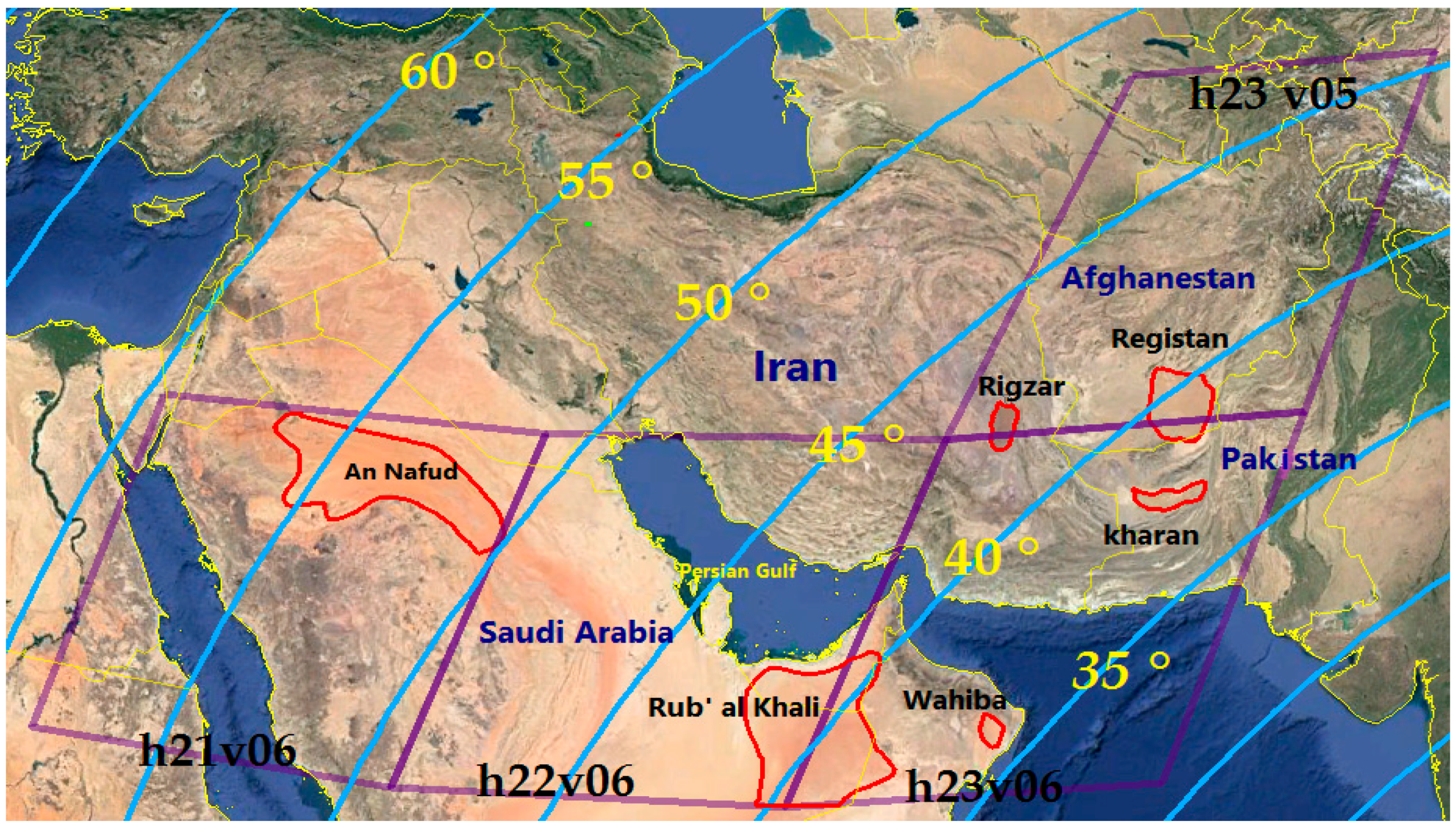
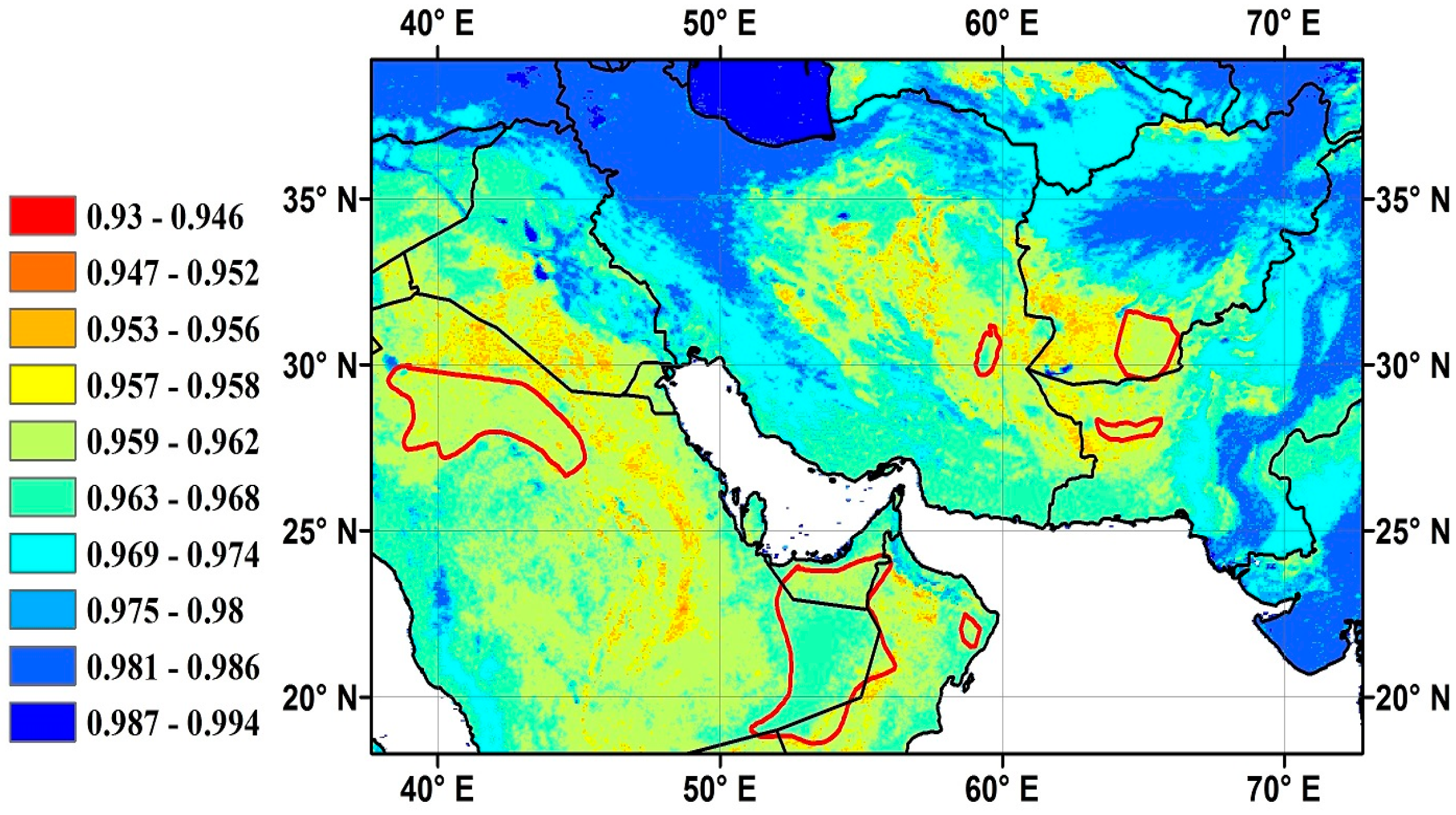
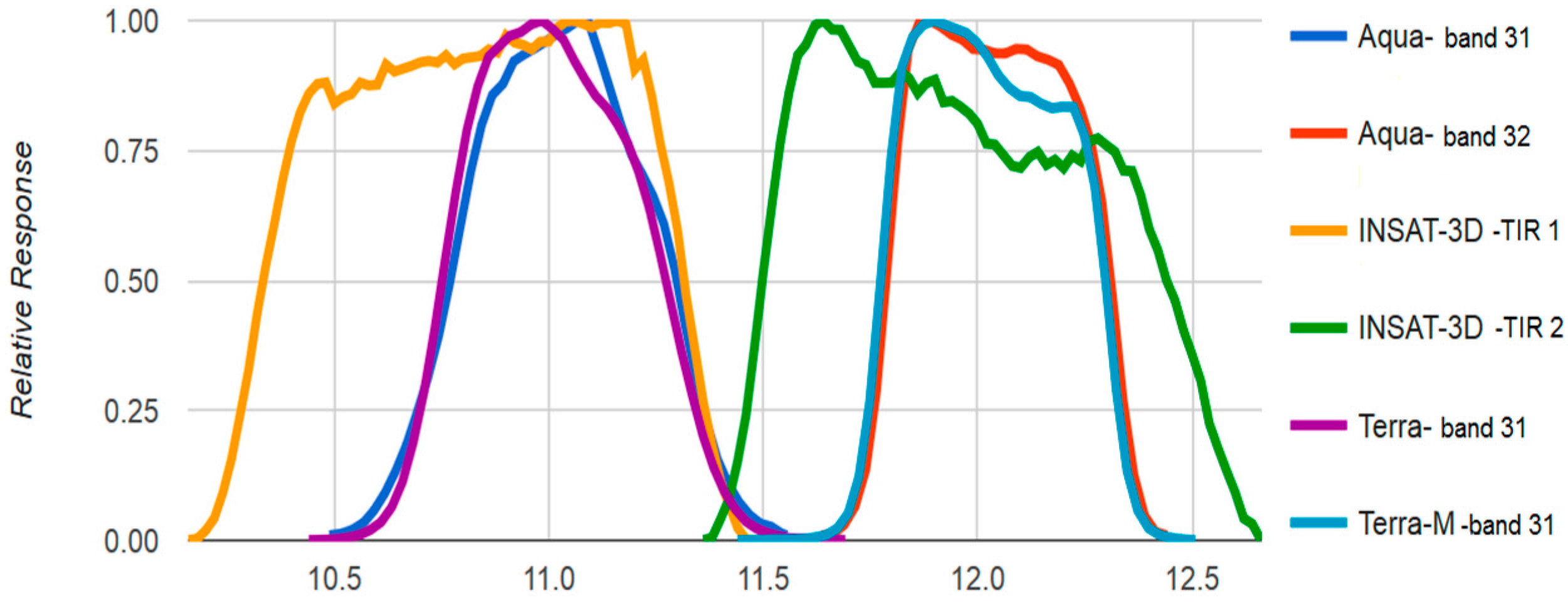
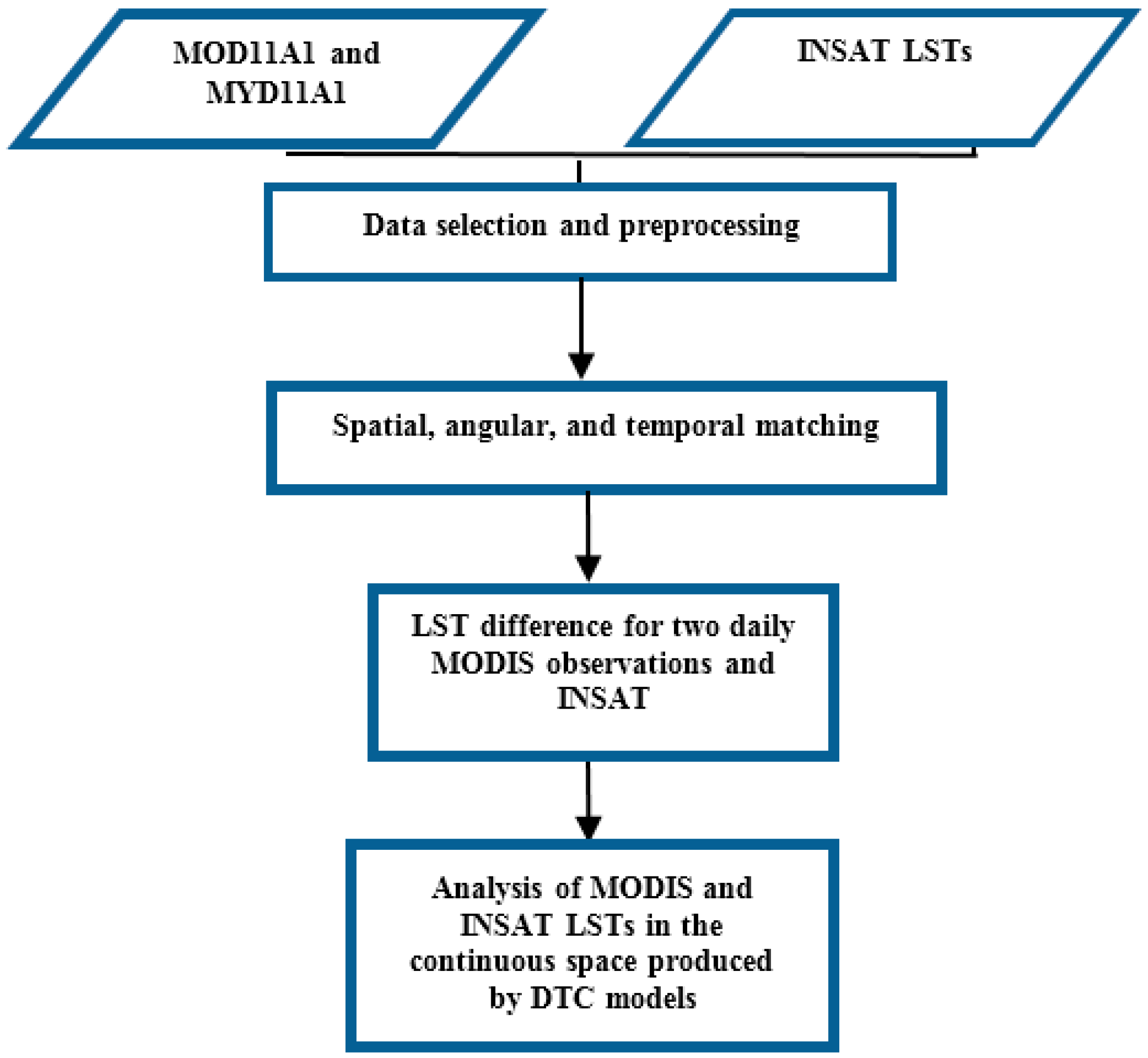
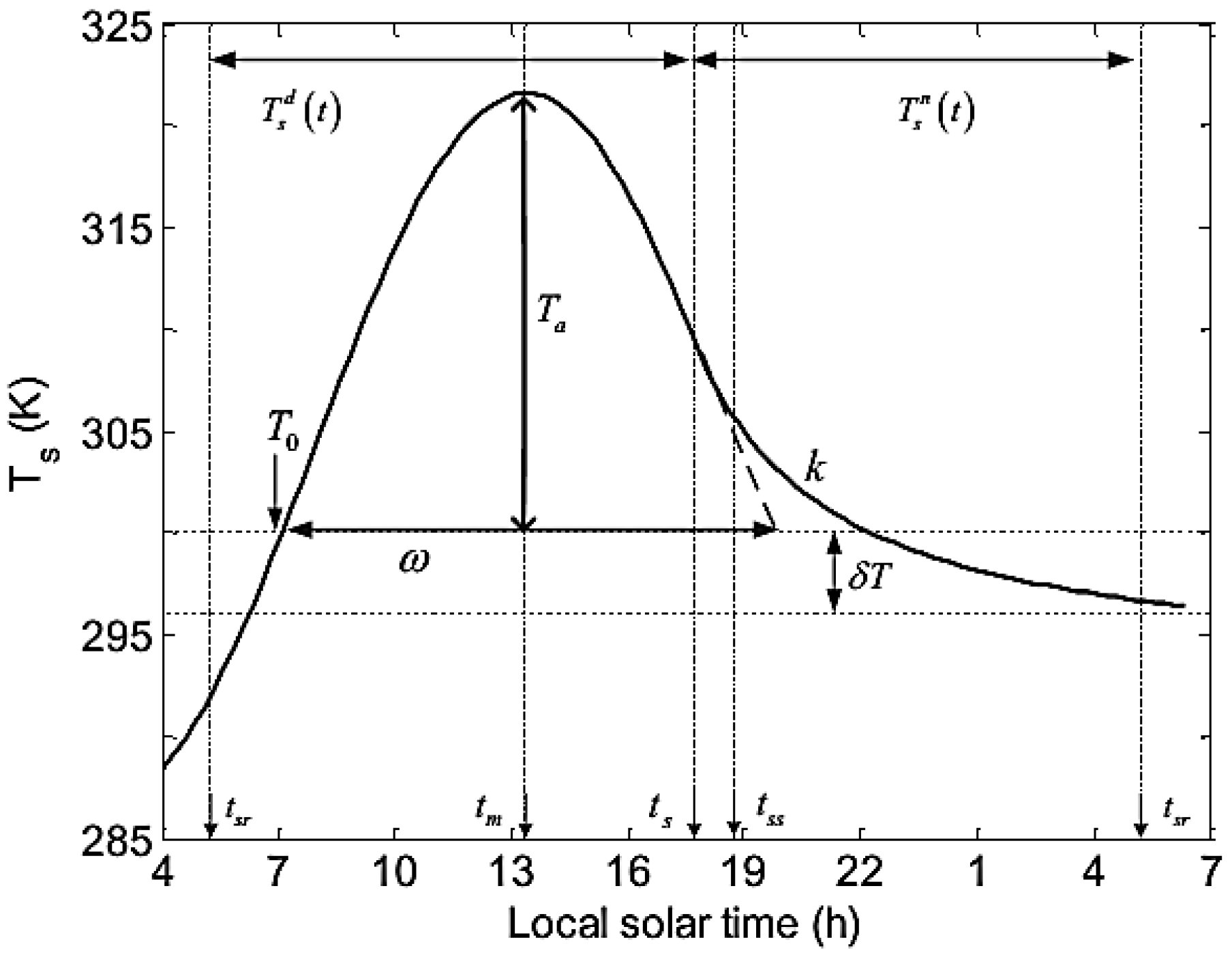
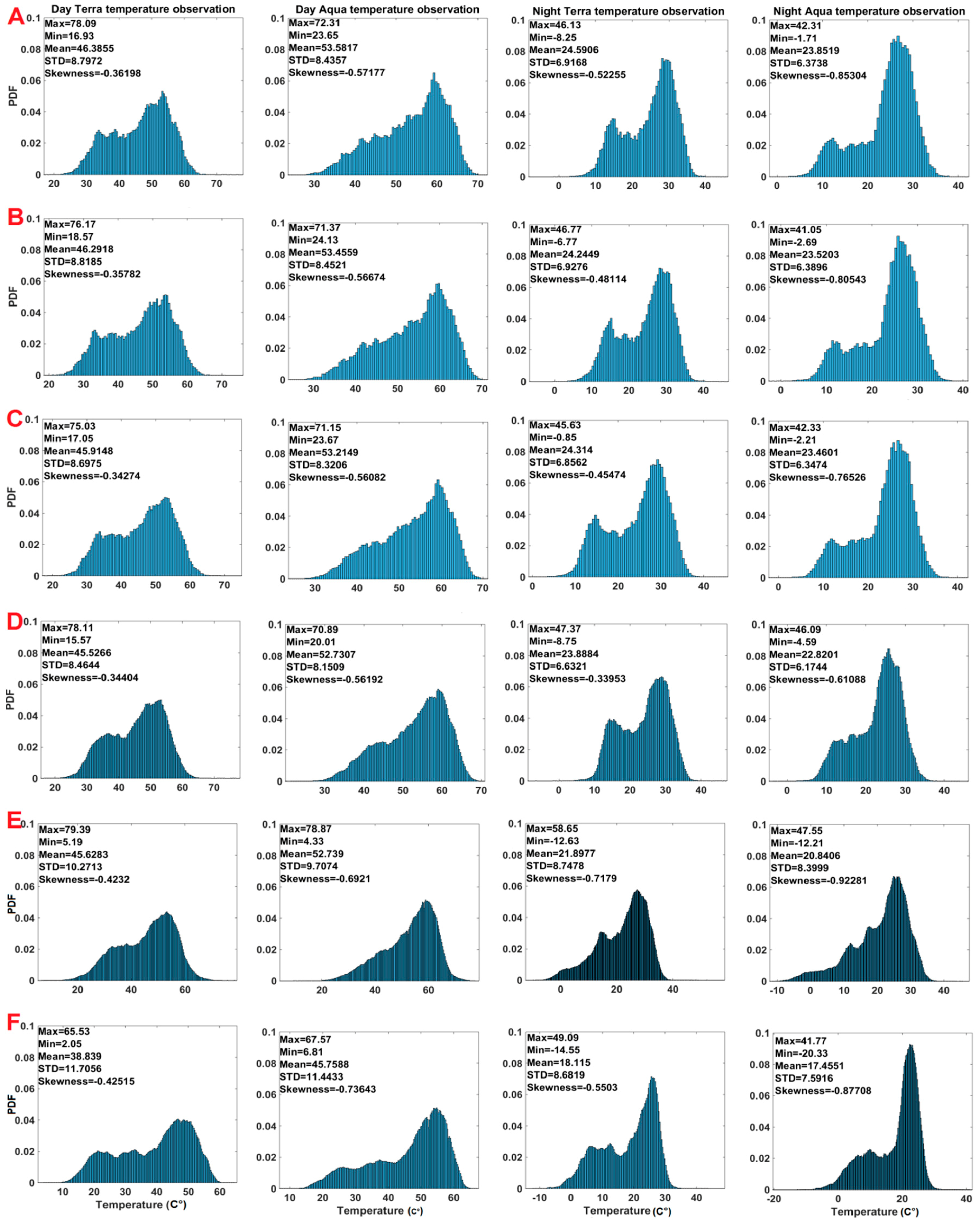
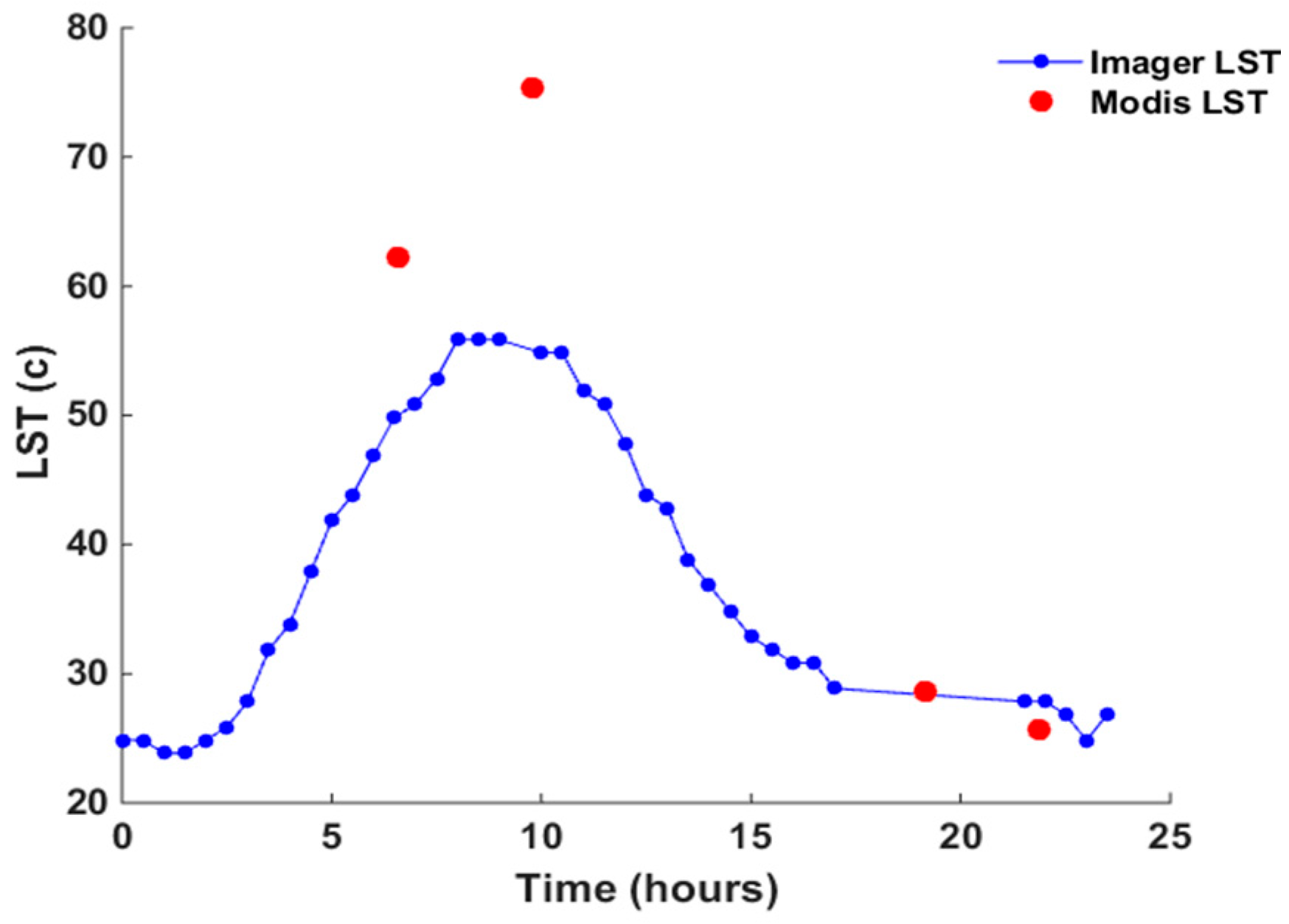
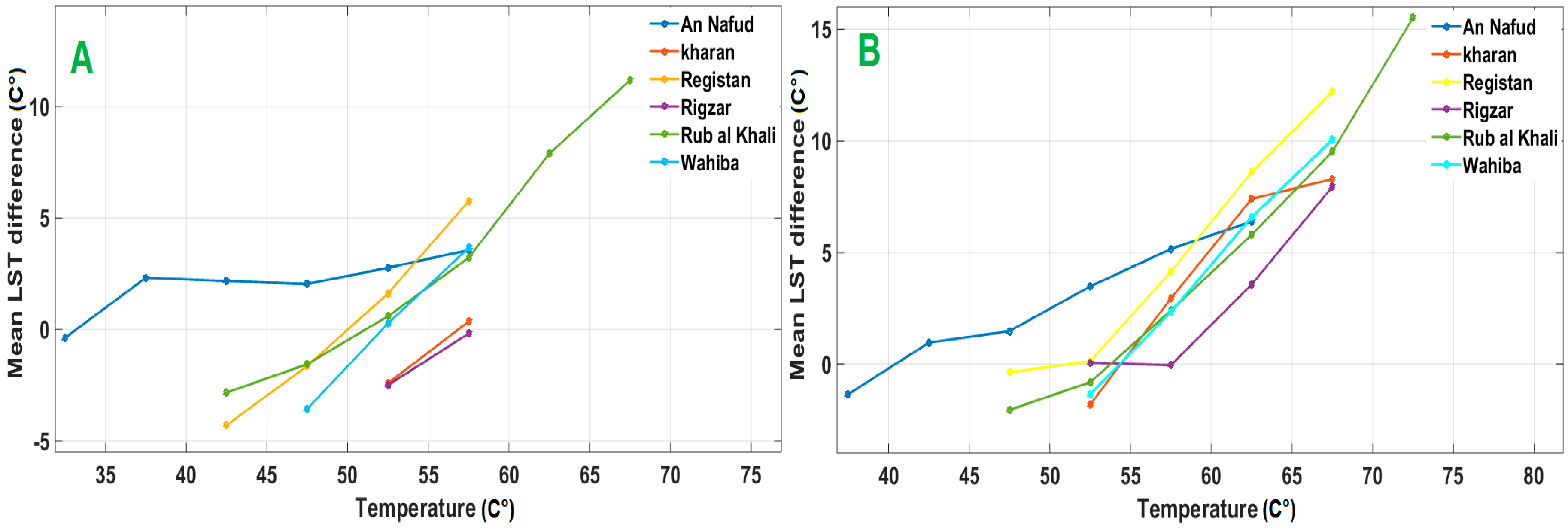

| Parameters | MODIS | INSAT-3D |
|---|---|---|
| Radiative transfer model | MODTRAN4 | MODTRAN4 |
| atmospheric surface boundary layer temperature range | 280–325 K for daytime 275–305 K for nighttime Total range: 275–325 K | 260 and 320 K |
| LST range | 288 and 354 K daytime 265 and 309 K nighttime Total range: 265–354 K | 260–330 K |
| water vapor | almost near zero to 5.5 cm | 0.1 g/cm2 to near saturated level (5 g/cm2 ) |
| VZA | 8 bins | 7 bins (0–20, 20–32.5, 32.5–37.5, 37.5–42.5, 42.5–47.5, 47.5–52.5, 52.5 and above). |
| Emissivity | MODIS emissivity product | MODIS emissivity product |
| MOD-D | 30–35 | 35–40 | 40–45 | 45–50 | 50–55 | 55–60 | 60–65 | 65–70 |
|---|---|---|---|---|---|---|---|---|
| An Nafud | 20 | 1459 | 7742 | 23021 | 30466 | 11687 | 0 | 0 |
| Kharan | 0 | 0 | 0 | 0 | 200 | 218 | 0 | 0 |
| Registan | 0 | 0 | 22 | 565 | 1417 | 846 | 0 | 0 |
| Rigzar | 0 | 0 | 0 | 0 | 515 | 366 | 0 | 0 |
| Rub al Khali | 0 | 0 | 129 | 2731 | 11536 | 15413 | 5085 | 1288 |
| Wahiba | 0 | 0 | 0 | 22 | 183 | 173 | 0 | 0 |
| MYD | 30–35 | 35–40 | 40–45 | 45–50 | 50–55 | 55–60 | 60–65 | 65–70 | 70–75 |
|---|---|---|---|---|---|---|---|---|---|
| An Nafud | 0 | 98 | 1652 | 10277 | 35260 | 47121 | 4613 | 0 | 0 |
| Kharan | 0 | 0 | 0 | 0 | 153 | 577 | 781 | 94 | 0 |
| Regisatan | 0 | 0 | 0 | 247 | 2684 | 6827 | 8065 | 777 | 0 |
| Rigzar | 0 | 0 | 0 | 0 | 92 | 1083 | 1865 | 465 | 0 |
| Rub al Khali | 0 | 0 | 0 | 1341 | 7822 | 17173 | 20420 | 5131 | 817 |
| Wahiba | 0 | 0 | 0 | 0 | 106 | 245 | 660 | 159 | 0 |
© 2017 by the authors. Licensee MDPI, Basel, Switzerland. This article is an open access article distributed under the terms and conditions of the Creative Commons Attribution (CC BY) license (http://creativecommons.org/licenses/by/4.0/).
Share and Cite
Alavipanah, S.K.; Weng, Q.; Gholamnia, M.; Khandan, R. An Analysis of the Discrepancies between MODIS and INSAT-3D LSTs in High Temperatures. Remote Sens. 2017, 9, 347. https://doi.org/10.3390/rs9040347
Alavipanah SK, Weng Q, Gholamnia M, Khandan R. An Analysis of the Discrepancies between MODIS and INSAT-3D LSTs in High Temperatures. Remote Sensing. 2017; 9(4):347. https://doi.org/10.3390/rs9040347
Chicago/Turabian StyleAlavipanah, Seyed Kazem, Qihao Weng, Mehdi Gholamnia, and Reza Khandan. 2017. "An Analysis of the Discrepancies between MODIS and INSAT-3D LSTs in High Temperatures" Remote Sensing 9, no. 4: 347. https://doi.org/10.3390/rs9040347







